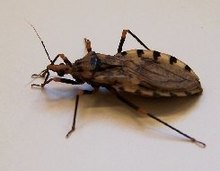
Back فسافس Arabic চুমুয়াল Bengali/Bangla Triatominae German Triatominae Spanish ساسهای بوسهزن Persian Triatominae French Triatominae Italian 트리아토마아과 Korean Triatominae Dutch Wóónaalzheehí atsʼǫǫsígíí NV
| Triatominae Temporal range:
| |
|---|---|

| |
| Scientific classification | |
| Domain: | Eukaryota |
| Kingdom: | Animalia |
| Phylum: | Arthropoda |
| Class: | Insecta |
| Order: | Hemiptera |
| Suborder: | Heteroptera |
| Family: | Reduviidae |
| Subfamily: | Triatominae Jeannel, 1919 |
| Tribes | |
The members of the Triatominae /traɪ.əˈtɒmɪniː/, a subfamily of the Reduviidae, are also known as conenose bugs, kissing bugs (so-called from their habit of feeding from around the mouths of people),[1] or vampire bugs. Other local names for them used in the Americas include barbeiros, vinchucas, pitos, chipos and chinches. Most of the 130 or more species of this subfamily feed on vertebrate blood; a very small portion of species feed on invertebrates.[2][3] They are mainly found and widespread in the Americas, with a few species present in Asia and Africa. These bugs usually share shelter with nesting vertebrates, from which they suck blood. In areas where Chagas disease occurs (from the southern United States to northern Argentina), all triatomine species are potential vectors of the Chagas disease parasite Trypanosoma cruzi, but only those species that are well adapted to living with humans (such as Triatoma infestans and Rhodnius prolixus) are considered important vectors. Also, proteins released from their bites have been known to induce anaphylaxis in sensitive and sensitized individuals.[4][5]
- ^
 The dictionary definition of kissing bug at Wiktionary
The dictionary definition of kissing bug at Wiktionary
- ^ Sandoval, C.M.; Joya, M.I.; Gutiérrez, R.; Angulo, V.M. (2000). "Cleptohaematophagy of the Triatominae bug Belminus herreri". Medical and Veterinary Entomology. 14 (1): 100–1. doi:10.1046/j.1365-2915.2000.00210.x. PMID 10759319. S2CID 37984742.
- ^ Sandoval, C.M.; Duarte, R.; Gutiérrez, R.; Rocha, D.S.; Angulo, V.M.; Esteban, L.; Reyes, M.; Jurberg, J.; Galvão, C. (2004). "Feeding sources and natural infection of Belminus herreri (Hemiptera, Reduviidae, Triatominae) from dwellings in Cesar, Colombia". Memórias do Instituto Oswaldo Cruz. 99 (2): 137–140. doi:10.1590/S0074-02762004000200004. hdl:1807/2288. PMID 15250465.
- ^ The EAACI Food Allergy and Anaphylaxis Guidelines Group (August 2014). "Anaphylaxis: guidelines from the European Academy of Allergy and Clinical Immunology". Allergy. 69 (8): 1026–45. doi:10.1111/all.12437. PMID 24909803. S2CID 11054771.
- ^ Klotz, JH; Dorn, PL; Logan, JL; Stevens, L; Pinnas, JL; Schmidt, JO; Klotz, SA (Jun 15, 2010). ""Kissing bugs": potential disease vectors and cause of anaphylaxis". Clinical Infectious Diseases. 50 (12): 1629–34. doi:10.1086/652769. PMID 20462351.